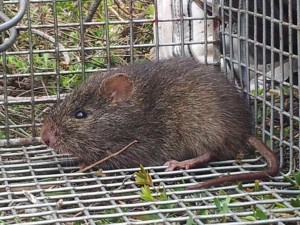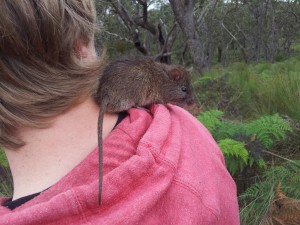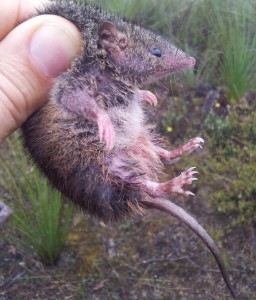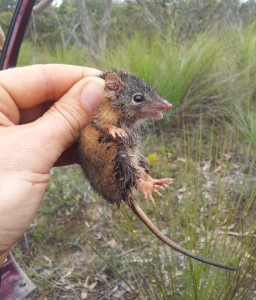A chance to revisit one of SA’s rarest mammals – the Heath Mouse
Over the past couple of weeks I’ve been getting re-acquainted with some sites in the Caroline Forest where I was involved in the discovery of the Heath Mouse (Pseudomys shortridgei) almost 10 years ago, when conducting surveys with Troy Horn (ForestrySA) and Dan Harley (now with Zoos Victoria) back in 2004. DEWNR has asked NGT to conduct surveys to check on the status of the species at previously known locations in the South East of SA, and 2 of the 3 known small reserves where they occur in SA have again been trapped in the past fortnight – with some positive results. Eleven consecutive nights of trapping, covering 10 sites, resulted in 31 captures of 12 different individual Heath Mice from 4 sites.

A Heath Mouse (Pseudomys shortridgei) captured during the recent survey. Note the very small punch of skin missing from the ear facing the camera. This ear sample doubles as both a unique mark for identifying each specific previously captured animal, as well providing a tissue sample (preserved in saline/alcohol solution) for future genetic studies that may assist in planning for the species’ long-term conservation.

A Bush Rat (Rattus fuscipes) – the most common species captured during the recent survey – and the species most at risk of being confused by the average person with the Heath Mouse. Instead of heading immediately back to the bush, this Bush Rat decided to climb Caleb and have a bit of a look around before making tracks!
In an interesting bit of side-news, the survey also resulted in the first ever records of the Swamp Antechinus from Dry Creek Native Forest Reserve – a species more commonly associated with tea-tree swamp thickets than heathy woodlands (hence its name). Although this species occurs in the nearby (much larger) heathy woodland reserves of Lower Glenelg and Rennick in Victoria, this first time record is highly significant for this endangered species in SA, and implies that they have managed to recolonise the reserve over recent years. The survey resulted in 8 captures of 7 individual animals (from 2 sites) – so this clearly wasn’t a once-off record either.

The Swamp Antechinus (Antechinus minimus) – first record ever in Dry Creek NFR – and now the site of the most inland known population of this species in SA.

The Yellow-footed Antechinus (Antechinus flavipes) – the common woodland species of antechinus in the lower South East of SA and western Victoria – was also detected during the survey. Compared to the Swamp Antechinus, note the distinctive white eye-ring, yellow flanks and feet – and general (flatter) body shape more suited to tree-climbing than the stocky, ground-dwelling Swamp Antechinus.
In talking to Bryan Haywood from ForestrySA, it also seems that the Swamp Antechinus are not alone – with the Olive Whistler and Rufous Bristlebird having also appeared in Dry Creek NFR since the wetter climatic phase of a couple of years ago. ForestrySA’s corridor program (to progressively re-connect otherwise isolated bushland reserves) may also have played a part, with the Dry Creek NFR corridor parallel to the Border Rd, increasing the amount of cover available for species looking to head north to Dry Creek NFR from bushland adjacent to the Glenelg River.
Thanks to Caleb and Dale (fantastic, dedicated volunteers for the fortnight), as well as Oisín Sweeney (DEWNR), Bryan Haywood (ForestrySA), Jonathan and Dan (NGT) for helping out at various times as well.

